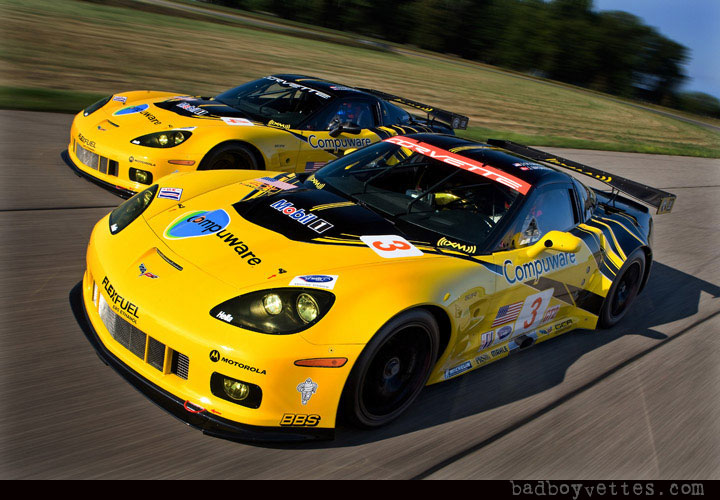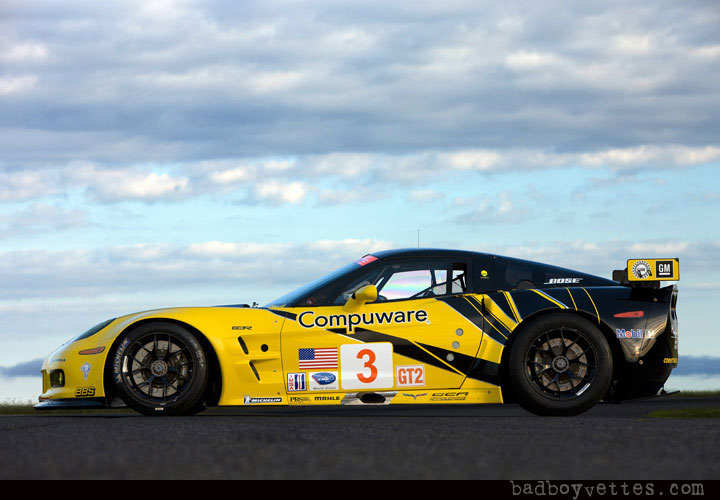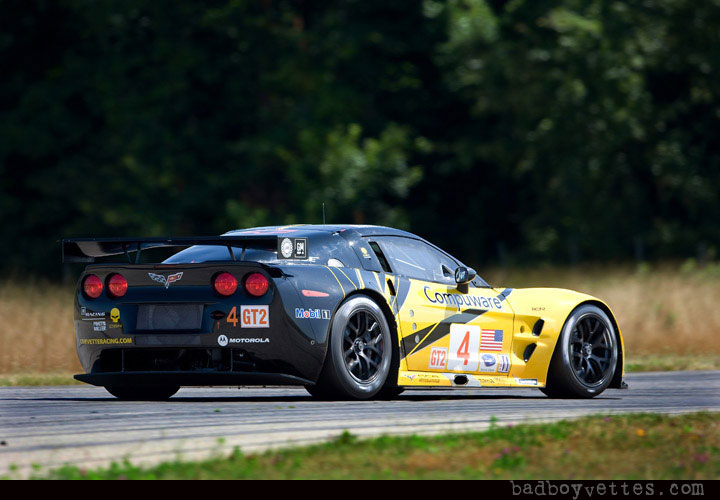Corvette Racing Finishes Second and Fourth in First GT2 Race
Magnussen and O'Connell Put New GT2 Corvette C6.R on Mid-Ohio Podium
LEXINGTON, Ohio, August 8, 2009 – It was the dawn of a new day for Corvette Racing at the Mid-Ohio Sports Car Course as the next-generation Corvette C6.R finished second and fourth in the hard-fought GT2 category in the sixth round of the American Le Mans Series. On an overcast and rainy day, the twin Corvettes shined as Johnny O'Connell and Jan Magnussen finished as runners-up in the No. 3 Compuware Corvette C6.R, 21 seconds behind the class-winning Porsche 911 RSR of Patrick Long and Joerg Bergmeister. Oliver Gavin and Olivier Beretta finished fourth in the No. 4 Compuware Corvette C6.R, one lap down after getting caught out by the safety car during a full-course caution.
"It was a really good run and we didn't have any issues," said Magnussen. "It's very difficult in traffic, even more difficult than with the GT1 cars. You really have to be smart and aggressive – this wasn't the race to risk the cars, so I lost a little time being too cautious. The GT2 Corvette C6.R is a fantastic race car, and very easy to drive fast. We still have a few minor things to sort out, but I think we're already there."
O'Connell took over from Magnussen at 1:27 into the two-hour, 45-minute race on the first pit stop for fuel and tires. He stopped again for five seconds of fuel at 2:02, while the class-leading Porsche team gambled on making it to the finish without a second pit stop. They won that bet, and O'Connell settled for second.
"Today was such an impressive debut for the new GT2 Corvettes, but I wouldn't expect anything less from this team," O'Connell said. "We've gained so much experience in GT1 over the years, and Corvette Racing sets the standards for car construction and preparation. It's great to be back, showing what Corvette and Chevrolet are all about."
As the race began under the threat of rain, the first start was waved off by officials. The field got the green flag on the next lap, and Magnussen quickly slotted into second, gaining a position on the No. 62 Ferrari. Farther back in the pack, Gavin was shuffled back to seventh. Gavin then methodically improved his position, gaining the third spot on the 20th lap. By the 22nd lap, the two Corvettes were running nose-to-tail in a familiar formation.
"Those first few laps were frantic," Gavin said. "The first start was waved off, we were forming up again, and it all got rather confusing. A BMW got by me, and then the Ford GT, so I had to hustle my way past them. We had a bit of contact, a little rubbing and banging. I got a few shoves, and I gave them back. GT2 is a great class to race in!"
As the sprinkles continued and the track became damp, the pace never slowed.
"It got a little loose sometimes, but because we had so much heat in the Michelin tires, it wasn't an issue for me," Magnussen explained.
The No. 4 Corvette pitted at 1:26 with Beretta replacing Gavin, and the No. 4 pitted one lap later with O'Connell replacing Magnussen. The decisive moment came at 1:50 when a full-course caution began when the No. 19 LMP2 prototype went off the track. The race leader was between the two Corvettes, which were four seconds apart on the track. Consequently the leading No. 45 Porsche and the second-place No. 3 Corvette gained nearly a full lap on the rest of the GT2 entries when officials began a wave-by to reform the field.
"There was a small gap between the Corvettes, and I could hear the excitement in (crew chief) Dan Bink's voice on the radio when he said, 'Don't let him by! Don't let him by!'" O'Connell recalled. "I already had that figured out, because it's happened to us enough over the years when we lost out on a safety car wave-by."
When racing resumed, a pack of five GT2 cars were fighting furiously for third place, separated by just 3.5 seconds. Beretta's No. 4 Corvette C6.R and the No. 92 BWM driven by Dirk Mueller eventually broke free, and Mueller took the third place on the podium with a pass going into the first turn with five minutes remaining.
"It's not our usual result, but nonetheless today was a great victory for Corvette Racing," said Corvette Racing program manager Doug Fehan. "To come out here with only a few days of testing on two brand-new race cars, run with the leaders, demonstrate our pit stop prowess and race strategy, and finish second is a testament to how hard this team works. I think every fan of sports car racing now knows there is going to be some spectacular GT racing in the American Le Mans Series."
The ethanol-powered Corvette C6.Rs also swept the top two spots in the MICHELIN GREEN X Challenge with the best overall scores among the 26 GT and prototype entries based on energy used, greenhouse gases emitted, and petroleum fuels displaced.
"Not only did we see a tremendous display of great planning and execution today, but also we saw Corvette win the MICHELIN GREEN X Challenge yet again," Fehan said. "That is emblematic of the new General Motors – fast, mean, lean, and green."
Corvette Racing’s next event is the Time Warner Cable Road Race Showcase featuring the American Le Mans Series at Road America in Elkhart Lake, Wis., on August 14-16. The two-hour, 45-minute race is scheduled to start at 2:05 p.m. CDT on Sunday, August 16. SPEED will televise the race live at 3 p.m. EDT.
Acura Sports Car Challenge of Mid-Ohio GT2 Results:
Pos./Drivers/Car/Laps
1. Bergmeister/Long, Porsche 911 GT3 RSR, 108
2. O'Connell/Magnussen, Chevrolet Corvette C6.R, 108
3. Mueller/Milner, BMW E92 M3, 107
4. Gavin/Beretta, Chevrolet Corvette C6.R, 107
5. Melo/Kaffer, Ferrari 430 GT, 107
6. Henzler/Ragginger, Porsche 911 GT3 RSR, 107
7. Farnbacher/James, Panoz Esperante GTLM, 107
8. Hand/Auberlen, BMW E92 M3, 106
9. Law/Neiman, Porsche 911 GT3 RSR, 104
10. Robertson/Robertson/Murry, Ford GT MK 7,
NEXT EVENT
August 16, Time Warner Cable Road Race Showcase featuring the American Le Mans Series, Road America, Elkhart Lake, Wis.
TV: SPEED live, 3 p.m. EDT






































